|
|
Product Numbers:
NM-1CT1, NM-1CT1-CSU, NM-2CT1, NM-2CT1-CSU, NM-1CE1-B, NM-2CE1-B, NM-1CE1-U, NM-2CE1-U
CPANM-1CT1, CPANM-1CT1-CSU, CPANM-2CT1, CPANM-2CT1-CSU, CPANM-1CE1-B, CPANM-2CE1-B, CPANM-1CE1-U, CPANM-2CE1-U
This document provides information about the following network modules for the Cisco 3600 series of modular access routers:
Unless specifically identified, references to PRI modules in this configuration note include all these network modules.


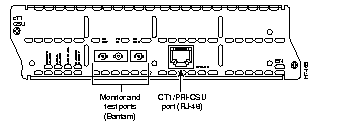
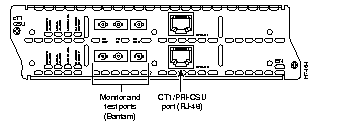




Use this document in conjunction with your router installation and configuration guide and the Regulatory Compliance and Safety Information publication. If you have questions or need help, refer to the section "Obtaining Service and Support" later in this document for further information.
This document contains the following sections: Safety Recommendations, page 5Required Tools and Equipment, page 7Installing PRI Network Modules in a Chassis Slot, page 7Connecting the PRI Module to the Network, page 9PRI Module Pinouts, page 12PRI Module LEDs, page 14Configuring the PRI Interfaces, page 17Obtaining Service and Support, page 22Cisco Connection Online, page 22Only trained and qualified personnel should be allowed to install or replace this equipment. (To see translated versions of this warning, refer to the Regulatory Compliance and Safety Information document that accompanied the router.)
 | Warning Before working on a chassis or working near power supplies, unplug the power cord on AC units; disconnect the power at the circuit breaker on DC units. (To see translated versions of this warning, refer to the Regulatory Compliance and Safety Information document that accompanied the router.) |
 | Warning Ultimate disposal of this product should be handled according to all national laws and regulations. (To see translated versions of this warning, refer to the Regulatory Compliance and Safety Information document that accompanied the router.) |
 | Caution To avoid damaging electrostatic discharge (ESD)-sensitive components, ensure that you have discharged all static electricity from your body before opening the chassis. Before performing procedures described in this document, review the next section, "Safety Recommendations." |
Follow these guidelines to ensure general safety:
 | Warning The ISDN connection is regarded as a source of voltage that should be inaccessible to user contact. Do not attempt to tamper with or open any public telephone operator (PTO)-provided equipment or connection hardware. Any hardwired connection (other than by a nonremovable, connect-one-time-only plug) must be made only by PTO staff or suitably trained engineers. (To see translated versions of this warning, refer to the Regulatory Compliance and Safety Information document that accompanied the router.) |
 | Warning Network hazardous voltages are present in the BRI cable. If you detach the BRI cable, detach the end away from the router first to avoid possible electric shock. Network hazardous voltages also are present on the system card in the area of the BRI port (RJ-45 connector), regardless of when power is turned off. (To see translated versions of this warning, refer to the Regulatory Compliance and Safety Information document that accompanied the router.) |
 | Warning Before working on equipment that is connected to power lines, remove jewelry (including rings, necklaces, and watches). Metal objects will heat up when connected to power and ground and can cause serious burns or weld the metal object to the terminals. (To see translated versions of this warning, refer to the Regulatory Compliance and Safety Information document that accompanied the router.) |
Follow these guidelines when working on equipment powered by electricity:
 | Warning Before opening the chassis, disconnect the telephone-network cables to avoid contact with telephone-network voltages. (To see translated versions of this warning, refer to the Regulatory Compliance and Safety Information document that accompanied the router.) |
 | Warning Do not work on the system or connect or disconnect cables during periods of lightning activity. (To see translated versions of this warning, refer to the Regulatory Compliance and Safety Information document that accompanied the router.) |
 | Warning Do not touch the power supply when the power cord is connected. For systems with a power switch, line voltages are present within the power supply even when the power switch is OFF and the power cord is connected. For systems without a power switch, line voltages are present within the power supply when the power cord is connected. (To see translated versions of this warning, refer to the Regulatory Compliance and Safety Information document that accompanied the router.) |
Electrostatic discharge (ESD) can damage equipment and impair electrical circuitry. It occurs when electronic printed circuit cards are improperly handled and can result in complete or intermittent failures. Always follow ESD prevention procedures when removing and replacing cards. Ensure that the router chassis is electrically connected to earth ground. Wear an ESD-preventive wrist strap, ensuring that it makes good skin contact. Connect the clip to an unpainted surface of the chassis frame to safely channel unwanted ESD voltages to ground. To properly guard against ESD damage and shocks, the wrist strap and cord must operate effectively. If no wrist strap is available, ground yourself by touching the metal part of the chassis.
 | Caution For safety, periodically check the resistance value of the antistatic strap, which should be between 1 and 10 megohms (Mohm). |
You need the following tools and equipment to install a network module in a Cisco 3600 series chassis slot:
 | Caution Network modules do not support online insertion and removal (hot swap). To avoid damaging the module, before you insert a network module into a chassis slot, you must turn OFF electrical power and disconnect network cables. |
The following instructions apply only to installing network modules in a chassis slot. To install a WAN interface card in a network module, see the configuration note for the WAN interface card.
You can install network modules in the chassis either before or after mounting the router, whichever is more convenient.
Follow this procedure to install a network module:
Step 1 Turn OFF electrical power to the router. However, to channel ESD voltages to ground, do not unplug the power cable. Remove all network interface cables, including telephone cables, from the rear panel.
The following warning applies to routers that use a DC power supply:
 | Warning Before performing any of the following procedures, ensure that power is removed from the DC circuit. To ensure that all power is OFF, locate the circuit breaker on the panel board that services the DC circuit, switch the circuit breaker to the OFF position, and tape the switch handle of the circuit breaker in the OFF position. (To see translated versions of this warning, refer to the Regulatory Compliance and Safety Information document that accompanied the router.) |
Step 2 Using either a number 1 Phillips screwdriver or a small flat-blade screwdriver, remove the blank filler panel from the chassis slot where you plan to install the module. Save the blank panel for future use.
Step 3 Align the network module with the guides in the chassis and slide it gently into the slot.
Step 4 Push the module into place until you feel its edge connector mate securely with the connector on the motherboard.
Step 5 Fasten the module's captive mounting screws into the holes in the chassis, using the Phillips or flat-blade screwdriver.
Step 6 If the router was previously running, reinstall the network interface cables and turn ON power to the router.
The following warning applies to routers that use a DC power supply:
 | Warning After wiring the DC power supply, remove the tape from the circuit breaker switch handle and reinstate power by moving the handle of the circuit breaker to the ON position. (To see translated versions of this warning, refer to the Regulatory Compliance and Safety Information document that accompanied the router.) |
If the router is not fully configured with network modules, make sure that blank panels fill the unoccupied chassis slots to provide proper airflow. (See Figure 9.)

This section explains how to connect a PRI network module to a WAN.
To connect a CT1/PRI module, use a DB-15-to-DB-15 T1 serial cable to connect the CT1/PRI port to a T1 CSU. (See Figure 10.)
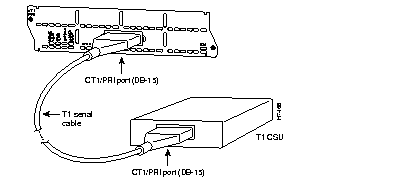
To connect a CT1/PRI-CSU module, use a straight-through RJ-48C-to-RJ-48C cable to connect the RJ-48C port to an RJ-48C jack. (See Figure 11.)
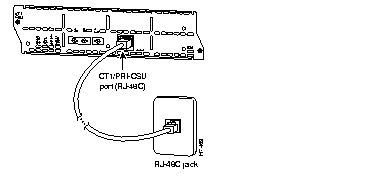
To connect a CE1/PRI-B (120-ohm) module, use the appropriate cable to connect the CE1/PRI-B port to an E1 CSU. (See Figure 12, Figure 13, and Figure 14, showing DB-15, Twinax, and RJ-45 CSUs respectively.)
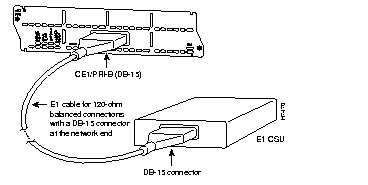
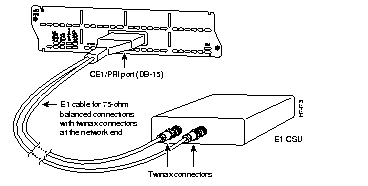
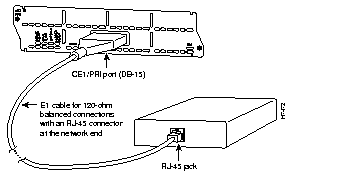
To connect a CE1/PRI-U (75-ohm) module, use the appropriate cable to connect the CE1/PRI-U port to an E1 CSU. (See Figure 15.) The illustration shows a CSU with BNC connectors.

This section describes PRI network module cables and lists their pinouts.
Two standard T1 serial cables are available for the CT1/PRI network module, straight-through and null-modem. A straight-through cable connects the router to an external channel service unit (CSU). Null-modem cables are used for back-to-back operation and testing.
T1 interface cables have two male DB-15 connectors (one at each end) to connect the CT1/PRI module with the external T1 CSU. Figure 16 shows the cable and connectors. Table 1 lists the pinout for the straight-through T1 cable, and Table 2 lists the pinout for the null-modem T1 cable.
| DB-15 Connector | DB-15 Connector | ||
|---|---|---|---|
| Signal | Pin | Pin | Signal |
| Transmit Tip | 1 | 1 | Transmit Tip |
| Transmit Ring | 9 | 9 | Transmit Ring |
| Receive Tip | 3 | 3 | Receive Tip |
| Receive Ring | 11 | 11 | Receive Ring |
| DB-15 Connector | DB-15 Connector | ||
|---|---|---|---|
| Signal | Pin | Pin | Signal |
| Transmit Tip | 1 | 3 | Receive Tip |
| Receive Tip | 3 | 1 | Transmit Tip |
| Transmit Ring | 9 | 11 | Receive Ring |
| Receive Ring | 11 | 9 | Transmit Ring |
Table 3 lists the pinout for the CT1/PRI-CSU network module.
| RJ-48C Pin | Signal |
|---|---|
| 1 | Receive Ring |
| 2 | Receive Tip |
| 4 | Ring |
| 5 | Tip |
Cisco Systems offers three serial cables for 120-ohm balanced CE1/PRI-B network modules and one serial cable for 75-ohm unbalanced CE1/PRI-U network modules. All four E1 cables have a DB-15 connector at the router end. Cables for CE1/PRI-B modules have either DB-15, Twinax, or RJ-45 connectors at the network end. (See Figure 17, Figure 18, and Figure 19.) The cable for CE1/PRI-U modules has a BNC connector at the network end. (See Figure 20.)




Table 4 lists pinouts for the CE1/PRI cables.
| CE1/PRI End | Network End | |||||||
|---|---|---|---|---|---|---|---|---|
| DB-15 | BNC | DB-15 | Twinax | RJ-45 | ||||
| Pin | Signal1 | Signal | Pin | Signal | Pin | Signal | Pin | Signal |
| 9 | Tx Tip | Tx Tip | 1 | Tx Tip | Tx-1 | Tx Tip | 4 | Tx Tip |
| 2 | Tx Ring | Tx Shield | 9 | Tx Ring | Tx-2 | Tx Ring | 5 | Tx Ring |
| 10 | Tx Shield | - | 2 | Tx Shield | Shield | Tx Shield | 6 | Tx Shield |
| 8 | Rx Tip | Rx Tip | 3 | Rx Tip | Rx-1 | Rx Tip | 1 | Rx Tip |
| 15 | Rx Ring | Rx Shield | 11 | Rx Ring | Rx-2 | Rx Ring | 2 | Rx Ring |
| 7 | Rx Shield | - | 4 | Rx Shield | Shield | Rx Shield | 3 | Rx Shield |
All network modules have an enable LED. This LED indicates that the module has passed its self-tests and is available to the router.
All PRI modules display four additional LEDs for each port. These LEDs are described in Table 5.
| LED | Meaning |
|---|---|
| REMOTE ALARM | Local alarm at remote end of connection |
| LOCAL ALARM | Loss of signal, loss of frame, or unavailability because of excessive errors |
| LOOPBACK | Controller local loopback |
| CARRIER DETECT | Carrier received on telco link |
The following sections illustrate these LEDs.
Figure 21 and Figure 22 show CT1/PRI network module LEDs.

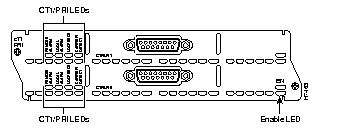
Figure 23 and Figure 24 show CT1/PRI-CSU module LEDs.


Figure 25 and Figure 26 show CE1/PRI module LEDs. The same LEDs are used for balanced (120-ohm) and unbalanced (75-ohm) E1 interfaces.

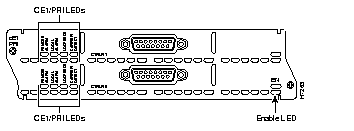
Whenever you install a new interface, or if you want to change the configuration of an existing interface, you must configure the interface. If you replace a module that was already configured, the router recognizes it and brings up the interface in the existing configuration.
Before you configure an interface, have the following information available:
 | Time Saver Obtain this information from your system administrator or network plan before you begin router configuration. |
To configure a PRI interface, you must use configuration mode (manual configuration). In this mode, you enter Cisco Internetwork Operating System (Cisco IOS) commands at the router prompt.
The following sections explain how to configure PRI interfaces. Before you begin, disconnect all WAN cables from the router to keep it from trying to run the AutoInstall process. The router tries to run AutoInstall whenever you power it ON if there is a WAN connection on both ends and the router does not have a valid configuration file stored in nonvolatile random-access memory (NVRAM) (for instance, when you add a new interface). It can take several minutes for the router to determine that AutoInstall is not connected to a remote Transmission Control Protocol/Internet Protocol (TCP/IP) host.
If you have questions or need help, refer to the section "Obtaining Service and Support" later in this document for further information.
The following procedure can be used to configure a new CT1/PRI or CT1/PRI-CSU module or to change the configuration of an existing module.
To enter configuration mode, follow this procedure:
Step 1 Connect a console to the router. If you need instructions for connecting a console, refer to the installation chapter of your router installation and configuration guide. Power up the router.
Step 2 If the current configuration is no longer valid, after about a minute you see the following prompt:
Answer no. You now enter the normal operating mode of the router.
Step 3 After a few seconds you see the user EXEC prompt (Router>). Type enable and the password to enter enable mode:
enable
Configuration changes can be made only in enable mode. The prompt changes to the privileged EXEC (enable) prompt (Router#):
Step 4 Enter the command config terminal to enter configuration mode:
config terminal
The router enters global configuration mode, indicated by the Router(config)# prompt.
Step 5 If you have not configured the router before, or want to change the configuration, configure global parameters, passwords, network management, and routing protocols. In this example, IP routing, AppleTalk routing, and Internetwork Packet Exchange (IPX) routing are all enabled:
ip routing
appletalk routing
ipx routing
For complete information about global configuration commands, refer to the Cisco IOS configuration guides and command references.
Step 6 Enter the controller t1 command to select the CT1/PRI interface to configure. For example, to configure a T1 interface in slot 1 and unit 0, enter the following command:
cont t1 1/0
Step 7 Specify the clock source for the module. The clock source command determines which end of the circuit provides clocking:
clock source line
Step 8 Specify the framing type:
framing esf
Step 9 Specify the line code format:
linecode b8zs
Step 10 Specify the channel group and time slots to be mapped. The command shown sets the channel group to 0 and selects time slots 1, 3 through 5, and 7 for mapping.
channel-group 0 timeslots 1,3-5,7 Step 11 After you define T1 channel groups, you can configure each channel group as a virtual serial interface. Specify the CT1/PRI interface, unit number, and channel group to modify, as in the following example:
int serial 1/0:0
Step 12 Assign an IP address and subnet mask to the interface using the ip address command, substituting the IP address and subnet mask for your site:
ip address 1.1.15.1 255.255.255.0
Step 13 Add any configuration commands needed to enable routing protocols or adjust the interface characteristics. Refer to the Cisco IOS configuration guides and command references for more information.
Step 14 If your router has more than one CT1/PRI interface, enter the exit command to return to the Router(config)# prompt. Repeat Step 6 through Step 13 of this procedure to configure the next CT1/PRI interface.
Step 15 By default, the router allocates 25 percent of dynamic random-access memory (DRAM) to shared memory (used for data transmitted or received by network modules and WAN interface cards). If your router includes multiple ISDN PRI interfaces, you must increase the amount of shared memory by entering the memory-size iomem command. The following example increases shared memory from 25 percent to 40 percent:
memory-size iomem 40
Step 16 When you are finished configuring interfaces, exit configuration mode and return to the enable prompt by pressing Ctrl-Z. To see the current operating configuration, including any changes you just made, enter the show running-config command:
show running-config
To see the configuration currently stored in NVRAM, enter the command show startup-config at the enable prompt.
show startup-config
Step 17 The results of the show running-config and show startup-config commands differ from each other if you have made changes to the configuration, but have not yet written them to NVRAM. To write your changes to NVRAM, making them permanent, enter the command copy running-config startup-config at the enable prompt:
copy running-config startup-config
The router is now configured to boot in the new configuration.
The following procedure can be used to configure a new CE1/PRI module (balanced or unbalanced) or to change the configuration of an existing module.
To enter configuration mode, follow this procedure:
Step 1 Connect a console to the router. If you need instructions for connecting a console, refer to the installation chapter of your router installation and configuration guide. Power up the router.
Step 2 If the current configuration is no longer valid, after about a minute you see the following prompt:
Answer no. You now enter the normal operating mode of the router.
Step 3 After a few seconds you see the user EXEC prompt (Router>). Type enable and the password to enter enable mode:
enable
Configuration changes can be made only in enable mode. The prompt changes to the privileged EXEC (enable) prompt (Router#):
Step 4 Enter the command config terminal to enter configuration mode:
config terminal
The router enters global configuration mode, indicated by the Router(config)# prompt.
Step 5 If you have not configured the router before, or want to change the configuration, configure global parameters, passwords, network management, and routing protocols. In this example, IP routing, AppleTalk routing, and IPX routing are all enabled:
ip routing
appletalk routing
ipx routing
For complete information about global configuration commands, refer to the Cisco IOS configuration guides and command references.
Step 6 Enter the controller e1 command to select the CE1/PRI interface to configure. For example, to configure an E1 interface in slot 1 and unit 0, enter the following command:
cont e1 1/0
Step 7 Specify the framing type:
framing crc4
Step 8 Specify the channel group and time slots to be mapped. The command shown sets the channel group to 0 and selects time slots 1, 3 through 5, and 7 for mapping:
channel-group 0 timeslots 1,3-5,7 Step 9 After you define E1 channel groups, you can configure each channel group as a virtual serial interface. Specify the CE1/PRI interface, unit number, and channel group to modify, as in the following example:
int serial 1/0:0
Step 10 Assign an IP address and subnet mask to the interface using the ip address command, substituting the appropriate IP address and subnet mask for your site:
ip address 1.1.15.1 255.255.255.0
Step 11 Add any configuration commands needed to enable routing protocols or adjust the interface characteristics. Refer to the Cisco IOS configuration guides and command references for more information.
Step 12 If your router has more than one CE1/PRI interface, enter the exit command to return to the Router(config)# prompt. Repeat Step 6 through Step 11 of this procedure to configure the next CE1/PRI interface.
Step 13 By default, the router allocates 25 percent of dynamic random-access memory (DRAM) to shared memory (used for data transmitted or received by network modules and WAN interface cards). If your router includes multiple ISDN PRI interfaces, you must increase the amount of shared memory by entering the memory-size iomem command. The following example increases shared memory from 25 percent to 40 percent:
memory-size iomem 40
Step 14 When you are finished configuring interfaces, exit configuration mode and return to the enable prompt by pressing Ctrl-Z. To see the current operating configuration, including any changes you just made, enter the show running-config command:
show running-config
To see the configuration currently stored in nonvolatile random-access memory (NVRAM), enter the command show startup-config at the enable prompt.
show startup-config
Step 15 The results of the show running-config and show startup-config commands differ from each other if you have made changes to the configuration, but have not yet written them to NVRAM. To write your changes to NVRAM, making them permanent, enter the command copy running-config startup-config at the enable prompt:
copy running-config startup-config
The router is now configured to boot in the new configuration.
For service and support for a product purchased from a reseller, contact the reseller. Resellers offer a wide variety of Cisco service and support programs, which are described in the section "Service and Support" in the information packet that shipped with your chassis.
For service and support for a product purchased directly from Cisco, use CCO.
CCO is Cisco Systems' primary, real-time support channel. SMARTnet customers and partners can self-register on CCO to obtain additional content and services.
Available 24 hours a day, 7 days a week, CCO provides a wealth of standard and value-added services to Cisco's customers and business partners. CCO services include product information, software updates, release notes, technical tips, the Bug Navigator, configuration notes, brochures, descriptions of service offerings, and download access to public and authorized files.
CCO serves a wide variety of users through two interfaces that are updated and enhanced simultaneously--a character-based version and a multimedia version that resides on the World Wide Web (WWW). The character-based CCO supports Zmodem, Kermit, Xmodem, FTP, and Internet e-mail, and is excellent for quick access to information over lower bandwidths. The WWW version of CCO provides richly formatted documents with photographs, figures, graphics, and video, as well as hyperlinks to related information.
You can access CCO in the following ways:
For a copy of CCO's Frequently Asked Questions (FAQ), contact cco-help@cisco.com. For additional information, contact cco-team@cisco.com.
Please use CCO to obtain general information about Cisco Systems, Cisco products, or upgrades. If CCO is not accessible, contact 800 553-6387, 408 526-7208, or cs-rep@cisco.com.

|
|